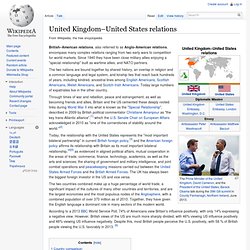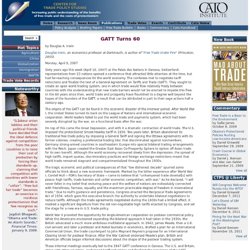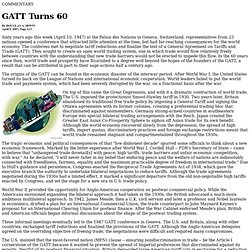

Bretton Woods system. The Bretton Woods system of monetary management established the rules for commercial and financial relations among the world's major industrial states in the mid-20th century.

The Bretton Woods system was the first example of a fully negotiated monetary order intended to govern monetary relations among independent nation-states. The chief features of the Bretton Woods system were an obligation for each country to adopt a monetary policy that maintained the exchange rate by tying its currency to gold and the ability of the IMF to bridge temporary imbalances of payments.
United Kingdom–United States relations. British–American relations, also referred to as Anglo-American relations, encompass many complex relations ranging from two early wars to competition for world markets.

Since 1940 they have been close military allies enjoying a "special relationship" built as wartime allies, and NATO partners. The two nations are bound together by shared history, an overlap in religion and a common language and legal system, and kinship ties that reach back hundreds of years, including kindred, ancestral lines among English Americans, Scottish Americans, Welsh Americans, and Scotch-Irish Americans. Today large numbers of expatriates live in the other country. Lend-Lease. President Roosevelt signs the Lend-Lease bill to give aid to Britain and China (1941) The Lend-Lease policy, formally titled An Act to Further Promote the Defense of the United States, (Pub.L. 77–11, H.R. 1776, 55 Stat. 3034, enacted March 11, 1941)[1] was a program under which the United States supplied Great Britain, the USSR, Free France, the Republic of China, and other Allied nations with materiel between 1941 and August 1945.

It was signed into law on March 11, 1941, a year and a half after the outbreak of World War II in Europe in September 1939 and nine months before the U.S. entered the war in December 1941. A total of $50.1 billion (equivalent to $656 billion today) worth of supplies were shipped, or 17% of the total war expenditures of the U.S.[2] In all, $31.4 billion went to Britain, $11.3 billion to the Soviet Union, $3.2 billion to France, $1.6 billion to China, and the remaining 2.6 to the other Allies.
Historical background[edit] Administration[edit] Significance[edit] ... Anglo-American loan. The Anglo-American Loan Agreement[1] was a post World War II loan made to the United Kingdom by the United States on 15 July 1946, and paid off 29 December 2006.[2] The loan was negotiated by John Maynard Keynes on behalf of the United Kingdom from the United States and Canada at the end of World War II.[3] Background[edit] The loan was made primarily to support British overseas expenditure in the immediate post-war years and not to implement the Labour government's welfare reforms.

British treasury officials believed they could implement the Labour government's domestic reforms without the loan if Britain withdrew from all major overseas commitments.[4] Additionally, Britain's lend-lease balance was written off for $650 million (US$8,515 million in 2014). Large quantities of goods were in Britain or in transit when Washington suddenly and unexpectedly terminated Lend-Lease on 29 August 1945.
Atlantic Charter. World Trade Organization. The World Trade Organization (WTO) is an organization that intends to supervise and liberalize international trade.

The organization officially commenced on 1 January 1995 under the Marrakech Agreement, replacing the General Agreement on Tariffs and Trade (GATT), which commenced in 1948.[5] The organization deals with regulation of trade between participating countries; it provides a framework for negotiating and formalizing trade agreements, and a dispute resolution process aimed at enforcing participant's adherence to WTO agreements, which are signed by representatives of member governments[6]:fol.9–10 and ratified by their parliaments.[7] Most of the issues that the WTO focuses on derive from previous trade negotiations, especially from the Uruguay Round (1986–1994).
The organization is attempting to complete negotiations on the Doha Development Round, which was launched in 2001 with an explicit focus on addressing the needs of developing countries. History[edit] Uruguay Round[edit] Cato's Center for Trade Policy Studies. By Douglas A.

Irwin Monday, April 9, 2007 Sixty years ago this week (April 10, 1947) at the Palais des Nations in Geneva, Switzerland, representatives from 23 nations opened a conference that attracted little attention at the time, but had far-reaching consequences for the world economy. The conferees met to negotiate tariff reductions and finalize the text of a General Agreement on Tariffs and Trade (GATT). They sought to create an open world trading system, one in which trade would flow relatively freely between countries with the understanding that new trade barriers would not be erected to impede this flow.
GATT at 60. By DOUGLAS A.

IRWINApril 9, 2007; Page A13. Flugzone cooperation. The Bermuda Agreement, reached in 1946 by American and British negotiators in Bermuda, was an early bilateral air transport agreement regulating civil air transport.

It established a precedent for the signing of approximately 3,000 other such agreements between countries. The Agreement was expanded in 1977. Full titles: Bermuda I.